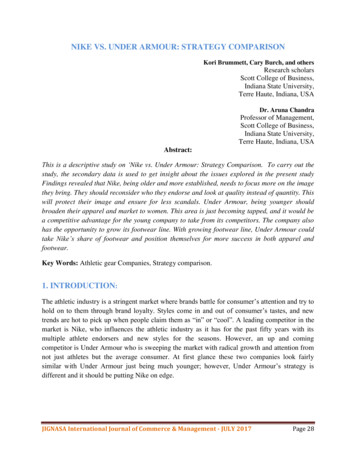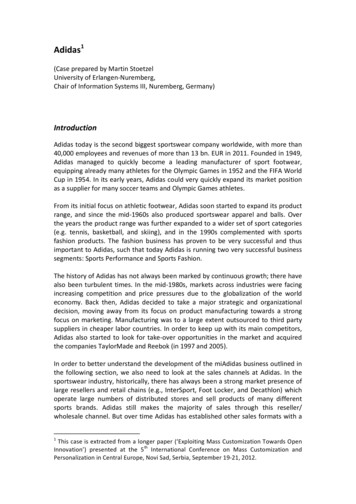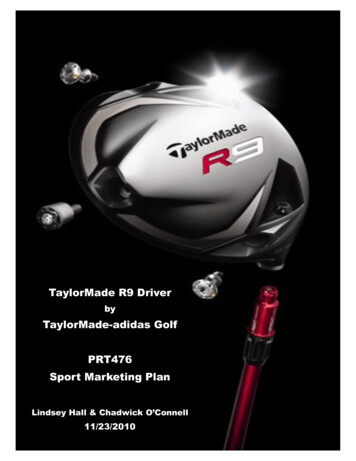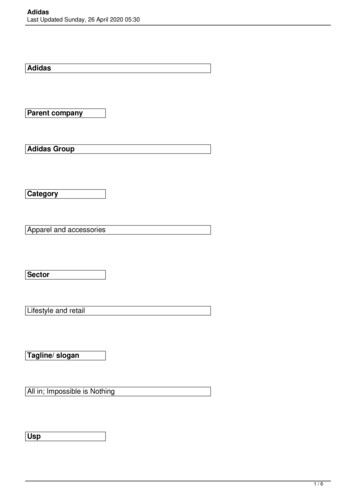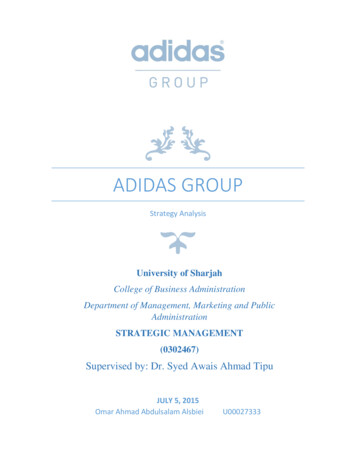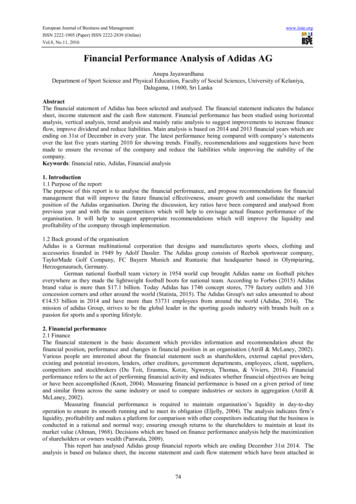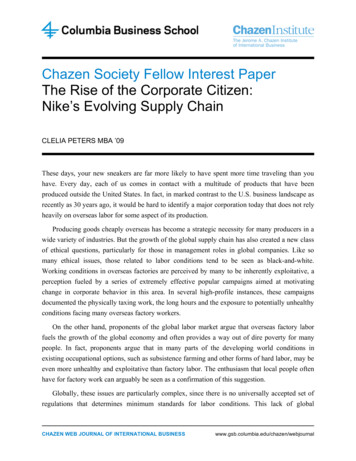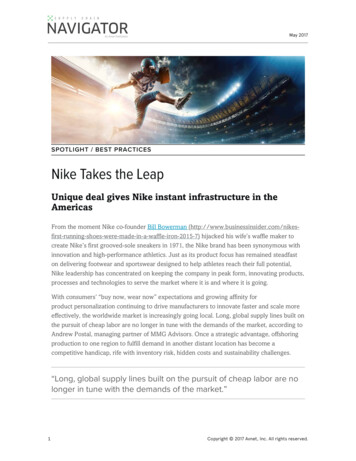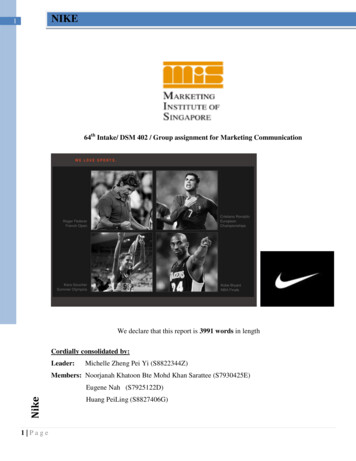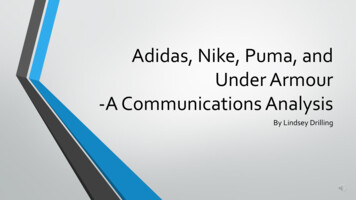
Transcription
Adidas, Nike, Puma, andUnder Armour-A Communications AnalysisBy Lindsey Drilling
Industry Fashion Industry The fashion industry primarily consists of making and selling clothes but also includesclothing design, manufacturing, distribution, marketing, advertising, retailing, andpromotion of all apparel.
List of Issues for the Fashion Industry withMedia Coverage Patent Infringement Labor Issues in their Factories New Product Releases Athletes, professional athletic teams or other celebrities using theirproducts Hiring new professionals into their C-Suite
About Adidas Founded on August 18, 1949 in Herzogenaurach, Germany. Publicly Owned, originally founded by Adi Dassler Key Products: Athletic Apparel and Sporting Equipment Subsidiaries: Reebok, Runtastic, TaylorMade-Adidas, Ashworth CEO: Kasper Rørsted
Adidas Key Challenges and News Stories Challenges: Rethink its marketing plan to maintain brand availability,inventory turnover and profit growth, Maintain connections with starathletes and sports teams, and Win Back Dominance in the United States Key News: Joins fight against marine plastic pollution by releasing first-everParleyeave adidas Z.N.E. Hoodie made with Parley Ocean Plastic yarn,Anticipates slower sales and profit loss, Closing stores in a shift to onlinestores, Security Breach
About Nike Began in 1964 as Blue Ribbon Sports, Company renamed Nike in 1978.Nike introduced in 1972 as a shoe line.Publicly owned, originally founded by Bill Bowerman and Phil KnightKey Products: Athletic Apparel, Sporting Equipment, and Sports TechnologyAccessoriesSubsidiaries: Air Jordan, Cole Haan, Converse, Hurley, Nike Golf, and UmbroCEO: Mark Parker
Nike Key Challenges and News Stories Challenges: Maintaining Rising Stock, Lost Rodger Federer Key News: Top Executives depart because of workplace behavioral issues,Problems with hiring women and minorities, Will not supply Iranian WorldCup team with shoes because of economic sanctions, Stock Increases, WorldCup
About Puma Founded on October 1, 1948 in Germany Publicly Owned, Originally founded by Rudolf Dassler, brother of Adidasfounder Adolf Dassler, after the brothers had a dispute. Key Products: Athletic Apparel and Sporting Equipment Subsidiaries: Cobra Golf, Dobotex CEO: Bjørn Gulden
Puma Key Challenges and New Stories Challenges: Former executive receives prison time for insider trading, Newpartnership with Jay-Z creates a conflict of interest between its involvementwith Puma and his sports agency, Roc Nation Key News: Signs major shoe deals with NBA Rookies Marvin Bagley III andMichael Porter Jr., Returning to professional basketball with Clyde CourtDispute basketball shoe
About Under Armour Founded in 1996 Publicly Owned, originally founded by Kevin Plank in the basement of hisgrandmother’s Washington D.C. Georgetown neighborhood house. Key Products: Athletic Apparel, Sporting Accessories, and SportingEquipment Subsidiaries: MapMyFitness, MyFitnessPal, and Endomondo. CEO: Kevin Plank
Under Armour Key Challenges and NewsStories Challenges: Loss of sales and lack of revenue in the United States market Key News: Female Executives are taking the lead in the athletic marketduring the #MeToo movement, Offers paid internships even though there isa federal law that makes it easier for companies to not pay interns
Objectives Evaluate each company’s performance on social media Compare the presence of each company in traditional media outlets Discover the key areas of difference in each company’s media presence Identify what makes something newsworthy in the athletic apparel industry
Metrics Traditional Media AnalysisNews Outlet VariationArticle Topic VariationFavorabilitySocial Media Analysis Social Media VolumeBrand AnalysisPublic OpinionOnline Reviews AnalysisPoint of Purchase
Traditional Media Analysis Metrics Results
News Outlet Variation Metrics Results
News Outlet Variation Metrics Results
News Outlet Variation Metrics Results
News Outlet Variation Metrics Results
Article Topic Variation Metrics Results
Article Topic Variation Metrics Results
Article Topic Variation Metrics Results
Article Topic Variation Metrics Results
Positive Coverage Guidelines Contains information about charitable work or initiatives where the company participatesCompany mentioned in the headline or first paragraph of an article has favorable coverageabout the companyContains more positive information about the company than negative informationEvokes positive emotions or reactions from the average readerGives the average reader a positive impression of the companyContains more positive messaging about the company than negative messagingContains quotes from company sources and third-party sources that enhance the overall imageof the company
Neutral Coverage Guidelines Company mentioned in headline or lead paragraph of article Any product release articles or information Does not give the reader any type of emotional connection Not many direct quotes Gives the reader more background information or indirect quotes Contains Balanced Positive and Negative Information
Negative Coverage Guidelines Company mentioned in the headline or lead paragraph of a news article that has predominately damaging informationContains more negative information about the company then positiveEvokes a negative emotion from the readerGive the average reader a pessimistic view of the companyHas more negative messaging about the company then positive messagingIncludes quotes from company sources or other third-party sources that does not enhance the company’s brand or imagePuts the company in the middle of a controversary or negative situationCompany spokespeople are mentioned in a scandal or a controversary
Favorability Metrics Results
Favorability Metrics Results
Favorability Metrics Results
Favorability Metrics Results
Social Media Analysis Metrics ResultsData Gathered on July 18, 2018
Social Media Volume Metrics ResultsDate Range: June 1, 2018- June 30, 2018
Brand Analysis Metrics Results An evaluation of each company’s CEO on social mediaGrading System: 1 point- does not have their own profiles on Facebook, Twitter, and Instagram2 points- has their own profiles on one of the social media platforms: Facebook, Twitter, orInstagram, posts at least once a week about company3 points- has their own profiles on two of the social media platforms: Facebook, Twitter, orInstagram, posts at least twice a week about company4 points- has their own profiles on two of the social media platforms: Facebook, Twitter, orInstagram, posts at least 4-5 times a week about the company5 points- has their own profile on all of the social media platforms: Facebook, Twitter, orInstagram, posts 5-6 times a week about the company
CEO Evaluation: AdidasCEOKasper RørstedFacebookNoneFacebook Posts Per WeekN/ATwitterNoneTwitter Posts Per WeekN/AInstagramNoneInstagram Posts Per WeekN/ATotal Points1 Point
CEO Evaluation: NikeCEOMark ParkerFacebookNoneFacebook Posts Per WeekN/ATwitterNoneTwitter Posts Per WeekN/AInstagramNoneInstagram Posts Per WeekN/ATotal Points1 Point
CEO Evaluation: PumaCEOBjørn GuldenFacebookNoneFacebook Posts Per WeekN/ATwitterNoneTwitter Posts Per WeekN/AInstagramNoneInstagram Posts Per WeekN/ATotal Points1 Point
CEO Evaluation: Under ArmourCEOKevin PlankFacebookYesFacebook Posts Per WeekNo PostsTwitterNoTwitter Posts Per WeekN/AInstagramkevinplank uaInstagram Posts Per Week1Total Points2 Points
Kevin Plank Facebook
Kevin Plank Instagram
Public Opinion Metrics Results
Online Reviews Analysis Metrics Results Better Business Bureau Ratings System: Opinion of how the business is likely to interact with its customersRating based on information received from the business and complaints from the publicUses information from businesses and public data sourcesRatings from A to FBBB will not rate the business (indicated by an NR, or "No Rating”) for reasons that includeinsufficient information about a business or ongoing review/update of the business’s file.
Online Reviews Analysis Metrics Results***Taken from the Better Business Bureau Website
Point of Purchase Metrics Results
Subject of Brand Analyses Social Media Strategy Product Marketing Strategy
Rating Scale for the Social Media Strategy 1 point- The company does not put any effort into communicating with customers on social media. There are no publicinteractions and the company does not respond to positive or negative comments.2 points- The company rarely interacts with customers on social media. It asks customers to communicate with themthrough private messaging. The company only responds to positive interactions not negative interactions. It takes at least1 day to get a response from the company.3 points- The company responds to customers on some of their social media platforms. Responses are made within 8hours of customer contact, but not all questions or complaints are acknowledged.4 points- Company responds to customers on most of their social media profiles. The company response is made within 4hours of customer interaction. The company helps the customer.5 points- Company responds to customer questions or complaints on all of their social media. The company answers thecustomers within 2 hours of customer contact. The company helps the customer with what they need within 8 hours ofinitial contact.
Social Media Strategy onsInstagramInteractionsTotal PointsAdidasNoneNoneNone1NikeNo public replies, buthas the very responsiveto private messagebadgeYes, replieswithin a dayNone2PumaNo public replies, butthe page says itresponds within a fewhoursNoneNone1Under ArmourNo public replies, butthe page says itresponds within a fewhoursYes, replies thesame dayYes replies, thesame day3
Rating Scale for Product Marketing Strategy 1 point- The brand does have its own social media, but it rarely used. The brand also has its own section onthe corporate website, but not its own website.2 points- The brand has its own social media and posts 1-2 times per week. The brand has its own website,but it is rarely used or updated.3 points- The brand has its own social media and posts 2-3 times per week. The brand has its own websiteand it is used and updated.4 points- The brand has its own social media and posts 3-4 times per week. The brand has its own websiteand it is used frequently. The website is updated and easy to use.5 points- The brand has its own social media and posts daily. The content is a variety of articles, videos, andpictures. The brand has its own website and it matches the look of the social media. The website is updatedand easy to use.
Product Marketing Strategy Results For AdidasBrandFacebookPosts onFacebookPer WeekTwitterPosts onTwitterPer WeekInstagram InstagramPosts PerWeekWebsiteTotalPointsReebokYes10Yes18Yes15Yes, OwnWebsite5RuntasticYes13Yes10Yes7Yes, OwnWebsite5TaylorMade- AdidasYes6Yes47Yes22Yes, OwnWebsite5AshworthNoN/AYesNoneNoN/AYes, but itis inactive1
Product Marketing Strategy Results For NikeBrandFacebookPosts onFacebookPer WeekTwitterPosts onTwitterPer WeekInstagramInstagramPosts PerWeekWebsiteTotalPointsAir JordanYes8Yes8Yes1Yes3Cole Yes1Yes1Yes3Yes1Nike GolfYes0Yes0Yes1Yes, hassectionon NikeWebsite1UmbroYes11Yes18Yes12Yes5
Product Marketing Strategy Results For PumaBrandFacebookPosts onFacebookPer WeekTwitterPosts onTwitterPerWeekInstagramInstagramPosts 4DobotexYes0Yes0Yes0Yes1
Product Marketing Strategy Results For UnderArmourBrandFacebookPosts onFacebookPer WeekTwitterPosts onTwitter PerWeekInstagramInstagramPosts 6Yes0Yes4
Survey Results
Responses for Other “I don’t purchase athletic apparel.” “Anything functional for running that isn't too bright. (not brand specific)” “TJ Maxx”
Responses for Other “Brand Preference” “How it fits me” “If my size is available” “Fit, fit fit! My body is a unique shape so I prioritize fit over anything. Then Ilook at the other factors.” “Spouse buys my clothing”
What influences your decision to NOT Purchase athletic apparelfrom Adidas, Nike, Puma, and Under Armour? Answered by 48 respondentsPriceDesignType of Fabric
Offer a variety of price pointsGood designsMore style and sizesNice quality (except for athletic shoes)
Thank You!
Adidas, Nike, Puma, and Under Armour-A Communications Analysis By Lindsey Drilling . Industry Fashion Industry The fashion industry primarily consists of making and selling clothes but also includes clothing design, manufacturing, distribution, marketing, advertising, retailing, and promotion of all apparel. List of Issues for the Fashion Industry with Media Coverage Patent .
